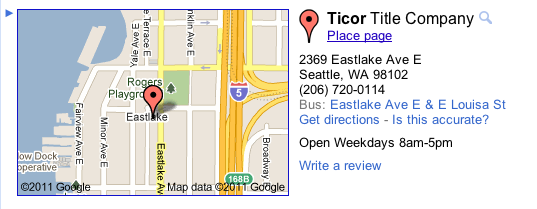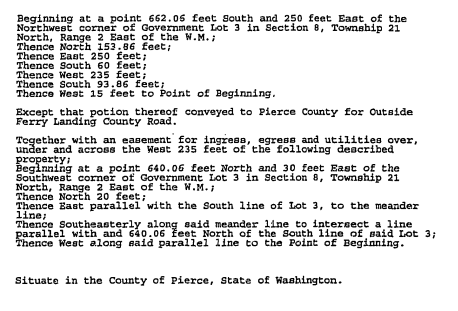As a part of our continuing effort to provide better service to our clients, we have taken the time to set up Google Places pages for each of our escrow branches in the Puget Sound area.
What is google places?
In a nutshell Google places allows a company to “claim” their business in Google’s index and subsequently provide accurate information about the company including phone, address, website, hours of operation, parking, amenities, photos of the building, videos and more.
A google places page should give consumers a good impression of the company, make it easy to find, and make it easy to provide feedback, and claim promotional offers.
The Results…
The result for our clients is that when they do a google search for “Ticor Seattle“, “Ticor Puyallup“, “Ticor Gig Harbor“, or any of our other locations, one of the first search results they should get is a street map with accurate information about each particular branch right next to it.
The Numbers…
When we first claimed our pages and filled them out, our main intention was to simply provide accurate info to google and hopefully boost our search engine presence by telling Google more about our escrow branches. But we really had no idea what to expect in terms of views, clicks, and consumer search behavior. And now that we have had a chance to view our page views and click metrics over a year, it’s quite amazing to see the numbers.
What can we learn about our clients / prospects?
When we log in to our google places dashboard we can learn valuable information about our clients (or potential clients). Here’s a list of info that Google tells us about each of our Place pages:
- Number of page views
- Page views by day of the week / month
- Number of clicks for more info
- Number of clicks for driving directions
- Number of clicks to our website
- Top search queries
- Where driving requests came from
What can we do to generate leads?
Like Yelp.com, Foursquare.com and other location-based social sites, Google places gives us a place to provide offers, discounts, coupons, etc.. For example we can add a coupon to our places page that reminds people of the discounts we offer on title and escrow when orders are placed electronically or when title and escrow are opened at the same time, etc…
A good place to be…
So in a nutshell, Google Places is free, it provides us with a means of providing accurate business information to people searching for us, it helps us to make a good impression, it tells us a bit about consumer search behavior, and allows us to generate leads. It makes good business sense, and that makes Google places a good place to be.
Have you used our google places pages to find one of our branches or provide directions to a client?
Let us know by leaving a comment below!









